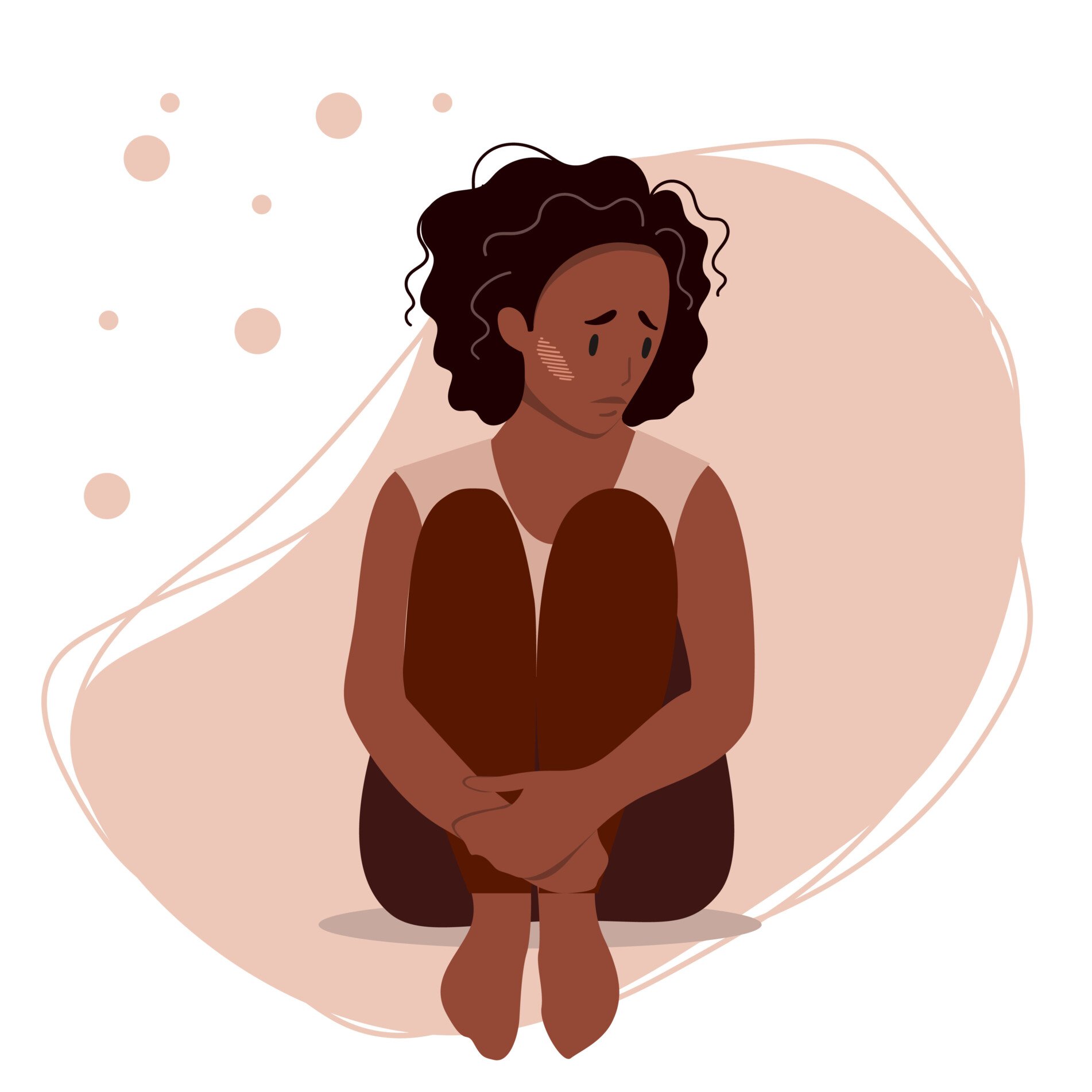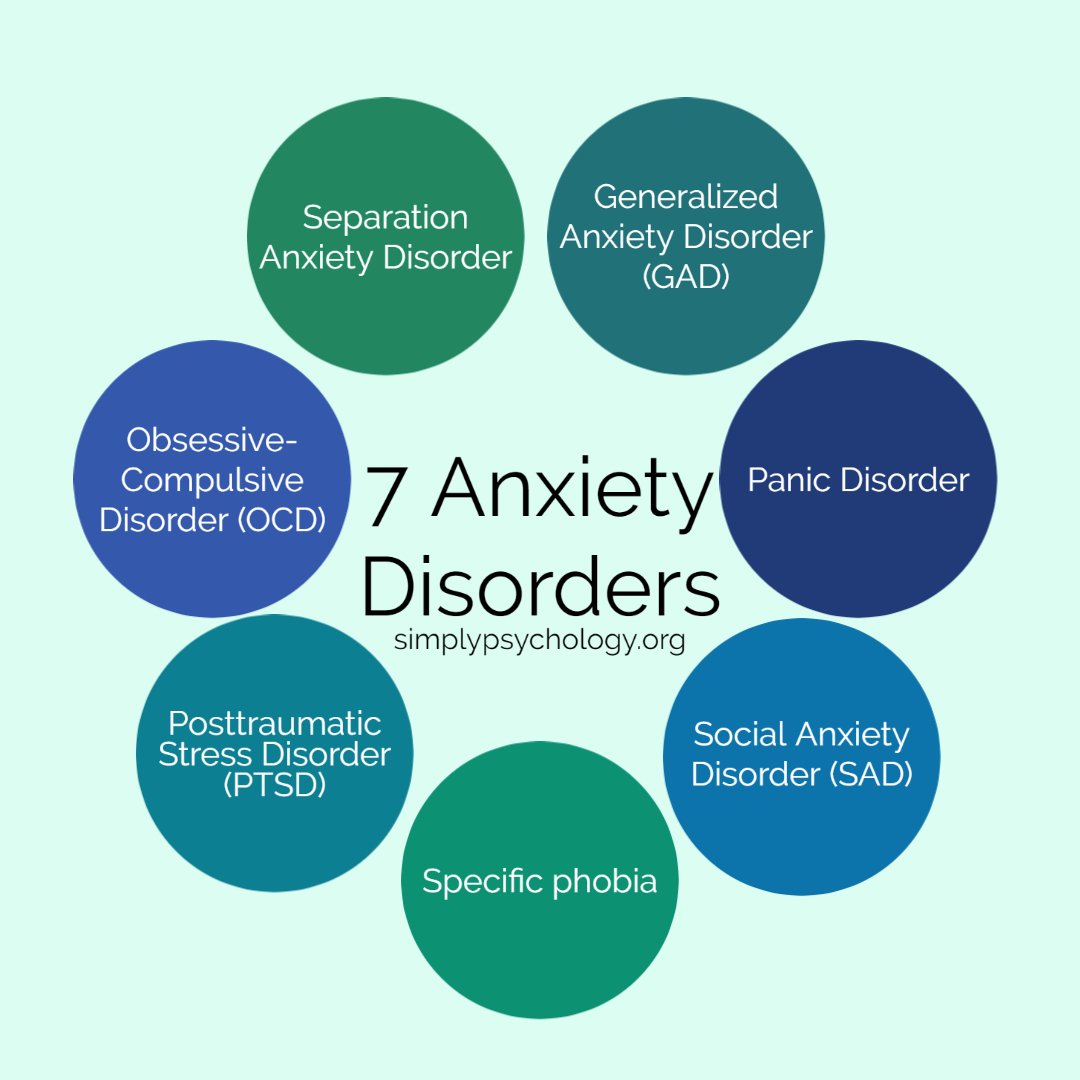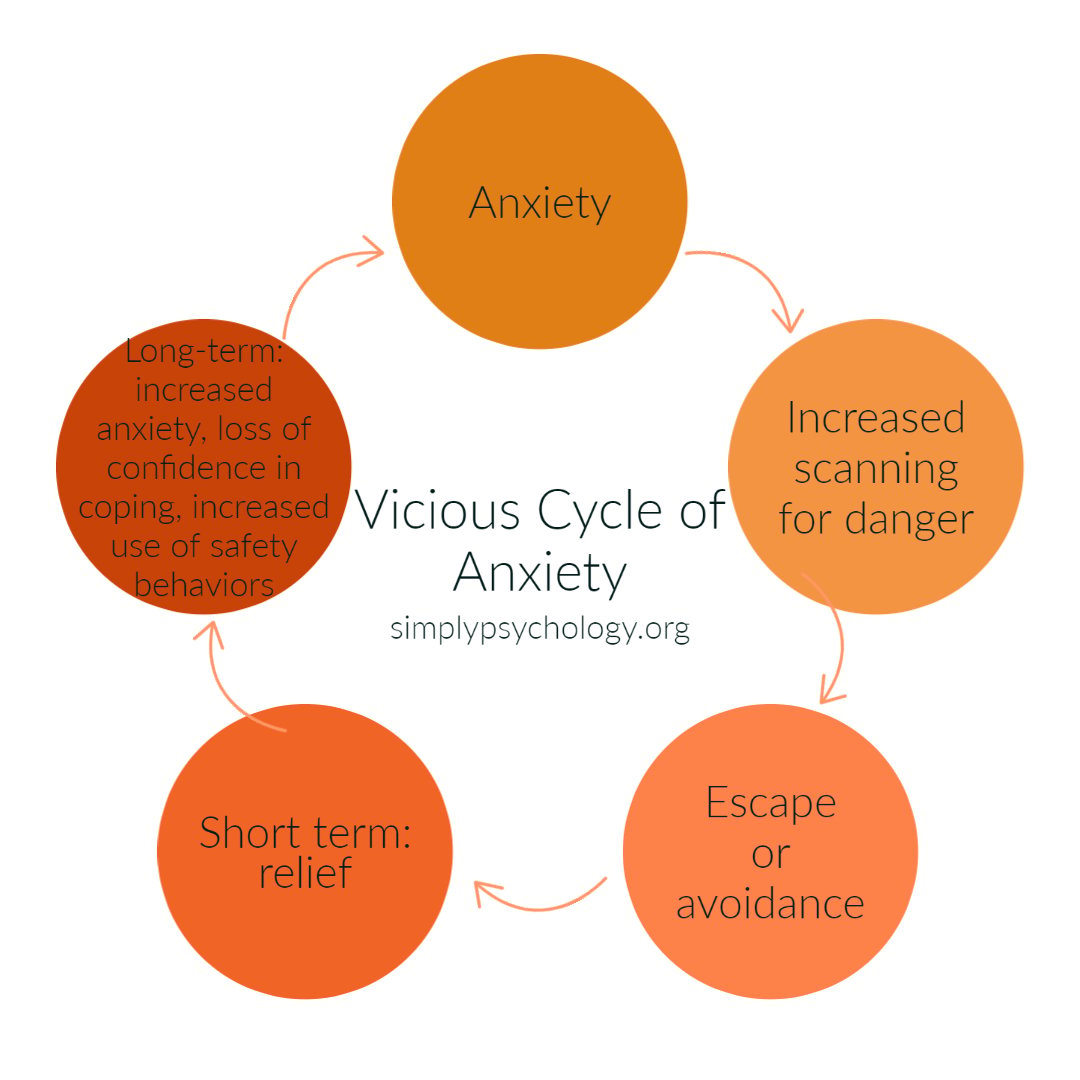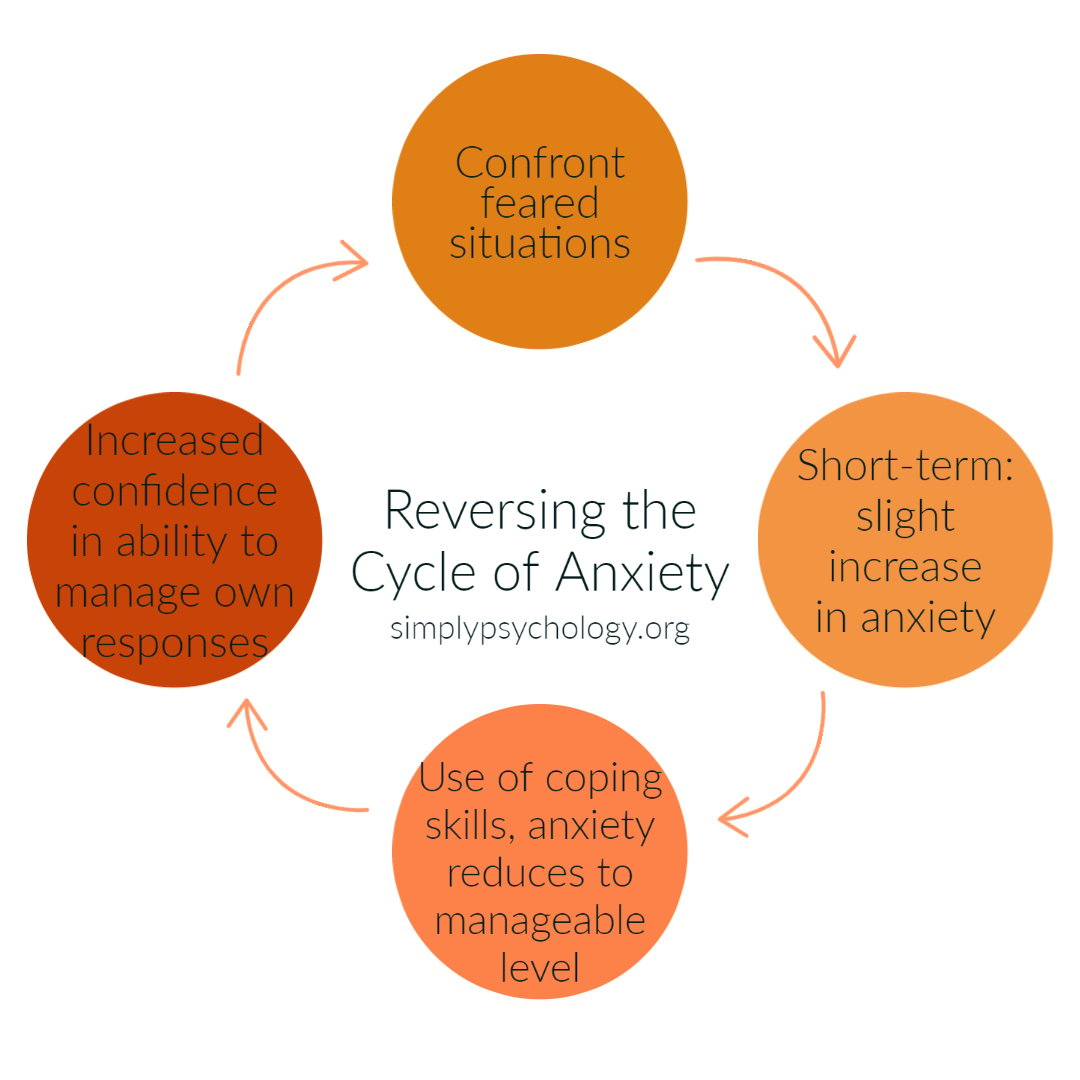On This Page:
Anxiety disorders are characterized by distressing, persistent anxiety and are often paired with unhelpful behaviors that individuals may use to try to reduce anxiety, such as avoidance or other safety behaviors.
For many people, anxiety can become a mental health concern if they find that they are regularly experiencing anxious feelings and their fears or worries are out of proportion to the situation.
If an individual finds that their anxiety is having a significant impact on their ability to live life as fully as they want, they may have a diagnosable anxiety disorder.
Approximately 1 out of 5 people are likely to experience a diagnosable anxiety disorder at some point in their lives. Some people may struggle with an anxiety disorder for months or years if left untreated; they could have more than one diagnosable anxiety disorder or find that their anxiety fluctuates or returns after treatment.
Signs can start at any time in life, begin as early as childhood or adolescence, and continue into adulthood.

Is some anxiety normal?
Anxiety is a natural human response associated with feelings of worry, being tense, or being afraid, when faced with situations that are considered threatening.
Humans evolved the fight or flight response to help protect us from dangerous situations. When experiencing a threat, our bodies release hormones, including adrenaline and cortisol, to make us feel more alert and produce bodily reactions such as increased heart rate and dilated pupils.
After the threat has passed, our bodies release other hormones to help the muscles relax. Thus, when we feel anxious, we experience this automatic response that cannot always be controlled.
Types of Anxiety Disorders
Anxiety disorders can be experienced in many ways. This article will discuss some of these disorders.
Please note that this is not an exhaustive list of anxiety disorders and that everyone can experience the disorders differently. This article should not be taken as a diagnostic tool. If you believe you or someone you know may have signs of an anxiety disorder, it is recommended to seek professional guidance.

Generalized anxiety disorder
Generalized anxiety disorder (GAD) is characterized by persistent and excessive worries about multiple things.
Someone with this disorder may excessively worry about their health, the health of others, finances, or safety, among other things.
These worries are out of proportion to the actual circumstance and are difficult to control. Often, individuals may feel uneasy or nervous or feel as if something bad is going to happen without a known reason.
GAD often comes with physical sensations such as stomach aches, and the worries can last for days, weeks, or months.
Panic disorder
Panic disorder is associated with sudden and intense feelings of anxiety and fear. This is characterized by panic attacks which involve intense physical sensations that are recurrent and often unexpected.
These panic attacks often reach a peak and typically last several minutes.
Social anxiety disorder
Social anxiety disorder is characterized by intense fear and anxiety in social situations.
People with social anxiety disorder often experience excessive worry about being judged or scrutinized by others and may avoid social situations altogether or endure them with extreme discomfort.
This can occur in most or all social situations, resulting in people with this disorder often avoiding social situations where they can.
Specific phobia
People who have specific phobias experience intense anxiety when exposed to a feared specific object or situation. Common specific phobias are spiders, snakes, heights, and confined spaces.
Specific phobias can produce an overwhelming and irrational fear of something that may pose little to no actual danger.
Exposure to a phobic object or situation can bring about severe anxiety and even provoke panic attacks. Therefore, individuals tend to avoid the phobia as much as possible.
Posttraumatic stress disorder
Posttraumatic stress disorder (PTSD) is a condition that is triggered by a traumatic event, either by experiencing the trauma or witnessing it. After the traumatic event, an individual may have recurring flashbacks, nightmares, or uncontrollable thoughts about the event.
These thoughts can bring about severe anxiety and a heightened sense of danger.
These individuals may feel stressed or fearful even in safe situations, and certain triggers that remind them of the event can cause anxious feelings.
Obsessive-compulsive disorder
Obsessive-compulsive disorder (OCD) is characterized by obsessive, intrusive thoughts and compulsive behaviors. Obsessive thoughts cause significant distress, and individuals feel driven to perform compulsive actions in order to ease their anxiety and distress.
For instance, someone with OCD may have obsessive thoughts about being contaminated and so may excessively wash their hands multiple times and for extended periods of time to decrease their stress.
People with OCD may perform ritualistic behaviors which interfere with their daily activities and can make their lives very difficult.
Separation anxiety disorder
Separation anxiety disorder is typically a childhood disorder associated with anxiety related to being separated from a parent or other people who play a parental role to the child.
The anxiety is excessive for a child’s developmental level. It can include the child being clingy, severely crying, refusing to go to school, or developing anxiety-related physical illnesses.
The child may have excessive worry about being apart from their parental figure, fear being lost from the parent, or fear that something bad will happen to the parent if the child is not with them.
Signs Of Anxiety Disorders
Anxiety disorders are usually experienced through thoughts, feelings, and physical sensations alongside behaviors typically resulting from the anxiety.
Below are some of the physical, cognitive, and behavioral signs that may be present in anxiety disorders. Note that someone does not have to experience every symptom to be diagnosed with an anxiety disorder.
Each person experiences anxiety disorders differently and may have some signs but not others. These lists are also not exhaustive, as people may experience other signs not listed.
Physical signs
-
Sweating
-
Trembling
-
Increased heart rate
-
Rapid breathing
-
Muscle tension
-
Dry mouth
-
Dizziness
-
Nausea
-
Stomach aches
-
Feeling fatigued
Cognitive signs
-
Difficulty controlling worries
-
Worry about the anxiety itself
-
Trouble concentrating
-
Sense of impending danger, panic, or doom
-
Mood swings or low mood
-
Repetitive thoughts
-
Uncontrollable thoughts
-
Panic, fear, and uneasiness
-
Negative thoughts about the world and the self
-
Tense or nervous
-
Anger or irritability
Behavioral signs
-
Avoiding things that trigger anxiety
-
Performing rituals
-
Seeking reassurance
-
Inability to be still
-
Unable to calm self
-
Isolating self
-
Trouble sleeping
-
Use of safety behaviors
There are also some complications that may arise from anxiety disorders, including, but not limited to:
-
Losing interest in previously enjoyed activities
-
Experiencing difficulties at work or school
-
Not being able to enjoy leisure time, e.g., being preoccupied with anxious thoughts
-
Struggling with trying to engage in new activities
-
Difficulties in relationships
-
The development of another mental health disorder, such as depression.
What Causes Anxiety Disorders?
There is not one known cause for the onset of anxiety disorders. Depending on the type of anxiety disorder being experienced, several factors could influence the likelihood of someone having a diagnosable disorder.
It is likely that a mixture of genetics, biology, and environmental factors play a role in the development of anxiety disorders.
Genetics
Genetics could play a role in the development of anxiety disorders. Having a close relative with anxiety may increase the risk of someone also developing anxiety.
Ayano et al. (2021) conducted a meta-analysis that suggested that parental psychiatric disorders could be associated with an increased risk of anxiety disorders developing in their children.
It was found that children with parents who have bipolar disorder are more at risk of developing obsessive-compulsive disorder and generalized anxiety disorder.
Likewise, children of parents with depressive disorder were at a higher risk of developing separation anxiety disorder, generalized anxiety disorder, and social anxiety disorder.
Biological causes
Biologically, a key area of the brain, the amygdala, is believed to play a role in anxiety-related signs.
The amygdala is a part of the limbic system involved in the processing and regulating of emotions, including fear. The prefrontal cortex of the brain, an area involved in critical thinking and reasoning, is believed to modulate the amygdala’s response to threats, providing rational thought to seemingly dangerous situations.
If there were disturbed amygdala-to-prefrontal cortex interactions, this is thought to influence anxiety as the amygdala may be overriding the part of the brain that is providing logical reasoning to perceived threats.
Learned experiences
Another contributing factor to anxiety disorders is learned experiences. As evident in studies from behaviorist psychology, people can be conditioned to learn to fear specific objects or situations. This fear can also be reinforced by avoiding the things which trigger anxiety, making it more likely that the anxiety will be strengthened.
Individuals may also learn through observations of other people displaying anxious behaviors. For instance, if children grow up in a household of a parent who has an anxiety disorder, the child may learn to be anxious about the same things.
Gender
It seems likely that cis-gender females are more likely than cis-gender males to develop an anxiety disorder.
Specifically, the rates of panic disorder, generalized anxiety disorder, phobias, separation anxiety, and PTSD appear to be higher in females than males.
In contrast, social anxiety disorder and OCD are the anxiety disorders more likely to affect males (Christiansen, 2015).
It is important to note that socialization and other environmental factors may play a role in the reasons why certain anxiety disorders are seemingly more common in specific genders.
Personality
An individual’s personality traits could also contribute to their likelihood of developing an anxiety disorder. For instance, those with timid temperaments, pessimistic outlooks, or those who tend to avoid anything dangerous may be more naturally anxious.
Moreover, those who scored highly on the personality dimension of neuroticism have consistently been found to be a risk factor for a range of anxiety disorders (Zhang et al., 2021).
Life events
Similarly, extreme stress or trauma at a young age is likely to have a negative impact on individuals. Children who experienced physical or emotional abuse, neglect, losing a parent, being bullied or socially excluded, or who had cold or overprotective parents may be more likely to develop anxiety disorders.
Also, current life stressors could contribute to the onset of anxiety disorders. Some stressors include pressure at work, big life changes, financial problems, the presence of other mental health problems, or changes in physical health.
It was found in a 2021 study that reported psychological distress following the COVID-19 outbreak was positively correlated with generalized anxiety disorder (Nikčević et al., 2021).
This makes sense considering many people during the pandemic may have developed more extreme worries over their health, the health of others, work, and financial matters – the major worries that people with generalized anxiety disorder have.
When to Seek Help
It is usually recommended to seek a professional support for a possible anxiety disorder when:
-
Anxiety significantly affects work, school, or other aspects of daily life.
-
There is a worry about the sensations being experienced or the high levels of anxiety.
-
The individual may rely on alcohol or other substances to cope with anxiety.
-
The individual has had treatment for anxiety before, and the signs have now returned.
-
The individual is having suicidal thoughts due to anxious feelings.
How Are Anxiety Disorders Managed?
The information provided on treatment options for anxiety disorders is for general knowledge and should not be considered a substitute for professional advice.
Not everyone may feel the need for treatment, as individual experiences with anxiety vary. Treatment can involve trial and error, with potential relapses and side effects. It’s important to understand that effectiveness varies from person to person.
If you’re considering treatment, it is strongly recommended to consult a qualified healthcare professional or mental health provider for personalized guidance. They can assess your needs, evaluate risks and benefits, and ensure a suitable treatment plan.
Psychotherapy
Psychotherapy is a general term for treating mental health problems by talking with a mental health provider.
During therapy sessions, individuals will learn more about their condition and their moods, feelings, thoughts, and behaviors.
Psychotherapy helps people learn how to take control of their lives and respond to challenging situations with healthy coping skills. Psychotherapy can be available in individual, couple, family, or group sessions, depending on what would be most effective for the individual.
Many types of psychotherapies that may be effective include:
-
Cognitive behavioral therapy (CBT) – is a very popular type of therapy that includes helping the individual to identify unhealthy, negative beliefs and behaviors and attempting to replace them with healthy, positive ones, as well as teaching coping skills for dealing with different problems.
-
Dialectical behavior therapy (DBT) – is a type of CBT that teaches behavioral skills such as mindfulness, emotion regulation, distress tolerance, and interpersonal effectiveness to help manage emotions and improve relationships with others.
-
Exposure therapy – this therapy can be incorporated into CBT and has proved useful, especially for those with specific phobias and social anxiety disorder.
This therapy involves gradually encountering the object or situation that triggers anxiety to build confidence so that the individual can manage to be around the object or in the situation and manage anxiety.
-
Acceptance and commitment therapy – this involves helping the individual with anxiety to become aware of and accept their thoughts and feelings and commit to making change, with the hope that this will increase their ability to cope with and adjust to situations.
Medications
Antidepressant medications are the commonly prescribed medications for anxiety disorders, specifically selective serotonin reuptake inhibitors (SSRIs).
SSRIs work by ensuring there is more of the neurotransmitter serotonin circulating around the brain.
These medications are thought to be more tolerable than other medications and can therefore be taken long-term. They can, however, cause some side effects, such as nausea, dry mouth, or some suicidal thoughts, especially when beginning to take the medication.
Benzodiazepines are a stronger type of anxiety medication, usually prescribed for those with severe signs who struggle significantly with daily life. Some examples of benzodiazepines include Alprazolam (Xanax), Clonazepam (Klonopin), and Lorazepam (Ativan).
Due to these medications being very strong, long-term use is not always recommended. They can also come with unpleasant side effects and be addictive, so they are usually prescribed in a low dose for a short period of time to help during a crisis period.
While there is a lot of support for the use of medication, it is worth bearing in mind that medications work differently for everyone, and thus, they may not be the right choice for many people.
Self-Care
Aside from medication and therapies, some lifestyle changes could be implemented into the lives of those struggling with anxiety, which could help with some of the anxious feelings:
-
Maintaining a healthy and balanced diet
-
Taking up regular exercise – aerobic exercise especially may help to ease anxious feelings
-
Avoiding stimulants such as caffeine – caffeine increases the heart rate, which can make people feel more nervous
-
Avoiding alcohol – alcohol can make people feel less anxious almost immediately, which is why many people with anxiety may use it to calm down. However, after consumption, people may feel more irritable or depressed or become reliant on substances which is an unhealthy coping mechanism.
-
Re-establishing routines, implementing breaks, setting realistic goals, reflecting on goals, and reviewing progress.
-
Taking up relaxing exercises such as yoga, mindfulness, and meditation
-
Maintaining a support network – talking with trusted friends and family members about worries and anxieties can unload a lot of the burden they are feeling
-
Sometimes just acknowledging the anxiety and accepting the feeling could help people work through their emotions and realize that they may be thinking irrationally.
Mindfulness
Mindfulness is the practice of focusing attention on the present moment without distraction. This can be practiced through meditation or even through completing everyday tasks that can help ‘ground’ a person (e.g., while folding laundry, going for a walk, or making a cup of tea).
While using mindfulness to focus on the present moment, we are less likely to be focused on negative thoughts, rumination, or worrying about the future. Thus, mindfulness may help to alleviate anxiety.
Breaking The Vicious Cycle Of Anxiety
For people with anxiety, they are more likely to be scanning their environment for potential threats. Thus, more attention is being paid to the things which trigger their anxiety.
Looking for potential threats can cause the physical sensations of anxiety to intensify.
To cope with anxiety, people will often either avoid or escape the situation, providing them instant, short-term relief. They may also use other types of safety behaviors to help them cope in anxiety-inducing situations.
For instance, someone with OCD will carry out their ritualistic behaviors, or someone with social anxiety disorder may pretend to look busy on their phone to avoid contributing to social situations.
Although these avoidance and safety behaviors can make someone feel better in the short term, these behaviors can be detrimental in the long term.
Avoiding high anxiety situations can result in an increase of physical sensations in similar situations in the future, cause a loss of confidence about being able to cope, and increase the use of safety behaviors.
Because of this, anxiety will keep going and may even get worse or be generalized to other situations. This is the vicious cycle of anxiety.


To be able to break the vicious cycle of anxiety, it is important to gradually confront the anxiety-inducing situation whilst learning to drop the safety behaviors.
For instance, someone with OCD can slowly begin to stop themselves from carrying out their ritualistic behaviors, or someone with social anxiety disorder can ensure they do not bring their phone to a social situation so that they are more likely to be involved in conversations.
In the short term, dropping these behaviors can result in increased feelings of anxiety. But after a while, the physical sensations of anxiety should decrease, and the behavior of scanning for potential threats should decrease.
Being able to break the cycle of anxiety is something that can be guided through with a therapist in psychotherapy if the individual feels they cannot do this on their own.
Over repeated exposure to high anxiety situations, while stopping safety behaviors, confidence in these situations should gradually increase.
Through individuals challenging themselves in structured and repeated ways, there should be a better chance of reducing anxiety overall.
Do you need mental health help?
USA
If you or a loved one are struggling with symptoms of an anxiety disorder, contact the Substance Abuse and Mental Health Services Administration (SAMHSA) National Helpline for information on support and treatment facilities in your area.
1-800-662-4357
UK
Contact the Samaritans for support and assistance from a trained counselor: https://www.samaritans.org/; email jo@samaritans.org .
Available 24 hours a day, 365 days a year (this number is FREE to call):
116-123
Rethink Mental Illness: rethink.org
0300 5000 927
References
Ayano, G., Betts, K., Maravilla, J. C., & Alati, R. (2021). A systematic review and meta-analysis of the risk of disruptive behavioral disorders in the offspring of parents with severe psychiatric disorders. Child Psychiatry & Human Development, 52(1), 77-95.
Behan, C. (2020). The benefits of meditation and mindfulness practices during times of crisis such as COVID-19. Irish journal of psychological medicine, 37(4), 256-258.
Christiansen, D. M. (2015). Examining sex and gender differences in anxiety disorders. A fresh look at anxiety disorders, 17-49.
Government of Western Australia. (n.d.). The Vicious Cycle of Anxiety. Centre for Clinical Interventions. Retrieved 2021, November 19, from: https://www.cci.health.wa.gov.au/~/media/CCI/Mental-Health-Professionals/Panic/Panic—Information-Sheets/Panic-Information-Sheet—03—The-Vicious-Cycle-of-Anxiety.pdf
Nikčević, A. V., Marino, C., Kolubinski, D. C., Leach, D., & Spada, M. M. (2021). Modelling the contribution of the Big Five personality traits, health anxiety, and COVID-19 psychological distress to generalised anxiety and depressive symptoms during the COVID-19 pandemic. Journal of Affective Disorders, 279, 578-584.
Zhang, F., Baranova, A., Zhou, C., Cao, H., Chen, J., Zhang, X., & Xu, M. (2021). Causal influences of neuroticism on mental health and cardiovascular disease. Human Genetics, 1-15.

